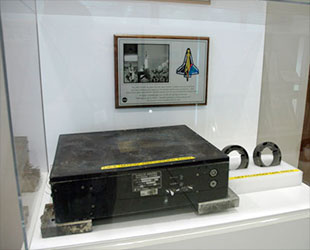 advertisements advertisements
|

|
Columbia debris goes on display at NASA

A data recorder recovered from the debris of the space shuttle Columbia on display at Johnson Space Center in Houston, TX. A new touring exhibit of Columbia hardware is aimed at safety. (cS) |
February 27, 2008 — A new exhibit aimed at promoting the importance of safety to NASA employees is using debris recovered from the loss of space shuttle Columbia to underscore its message.
Developed by the agency's space shuttle program office, the "Columbia Safety Exhibit" incorporates recognizable remnants of the fallen orbiter's hardware, including one of the flight deck window frames, control panels and hand controllers from the crew cockpit, heatshield tiles and one of the thrusters used to maneuver the spacecraft in orbit.
The concept of building a safety exhibit was spearheaded by outgoing shuttle program manager Wayne Hale, whose new appointment as deputy associate administrator for strategic partnerships was announced by NASA Feb. 22. Hale described the reason behind the exhibit in an e-mail sent to employees at Johnson Space Center in Houston.
"The only bulwark between an accident and a safe, successful space mission is the competence and attention of highly focused individuals. If we are to truly honor the sacrifice of these crews, we must teach that lesson to every new person that comes to work here and live each day with the utmost commitment to safety in all its details," said Hale.
"To this end, we have constructed a traveling memorial that will spend this year visiting every NASA center," he continued. "We hope this memorial will provide the thoughtful contemplation of our duty, similar to a visit to the Vietnam War memorial or Arlington," concluded Hale.
The glass-encased, self-standing safety exhibit features nine components from Columbia, including four pieces recovered from the compartment where the STS-107 crew rode. Nearby panels put each artifact into the context of position and use within the shuttle, including a controller used by Commander Rick Husband, a window that once overlooked the payload bay and a pyro initiator T-handle from the crew's access hatch.
Heatshield tiles and wing leading edge material are also displayed, as is one of the thrusters recovered from the nose of the orbiter.
The sides and back of the exhibit show photographs of the recovery and reconstruction of Columbia as a cause for the accident was sought and found, along with the inscription, "Everyone that touches a mission on every level, is responsible for what it represents and the lives that are involved." The word "Everyone" appears in several places alone, stressing the roll of all employees.
The Columbia Safety Exhibit first went on display at the Kennedy Space Center in Florida, in the lobby of one of its operation support buildings. Since February 26, it has been on display in the lobby of Johnson Space Center's headquarters building. It will remain in Houston for a few weeks, before continuing to 11 other NASA locations.
Additional stops planned for the exhibit include centers in Mississippi, Alabama, Ohio, Virginia, Washington, D.C., Maryland, New Mexico and California. Intended only for the space agency's employees, the display areas are not accessible by the general public.
The exhibit, which pays tribute to Columbia, the crew of STS-107, and the recovery effort following their loss, will ultimately return to Kennedy Space Center. There, the Columbia hardware will be added back to the controlled storage facility on the 16th floor of the Vehicle Assembly Building, where all 84,000 recovered parts are cataloged and preserved for posterity and research.
Space shuttle Columbia and its STS-107 flight crew of seven astronauts were lost on February 1, 2003 as they returned from space after a 16-day science mission. By studying the orbiter's debris, investigators concluded that a hole in Columbia's left wing was caused by its own fuel tank's insulation falling off and striking the vehicle during launch, leading to its later break-up during reentry.
The Columbia Safety Exhibit is not the first time NASA employees have had an opportunity to see the debris. In addition to access to the reconstruction hangar during the 2003 accident investigation, at least one component from the orbiter, a flight data recorder, has been on display at the Johnson Space Center since August 2007.
NASA has loaned pieces from the debris to researchers for study but to date, the hardware has not been lent to museums, though it was reported that several submitted requests for their displays. The Smithsonian's National Air and Space Museum in Washington, D.C. exhibits an embroidered STS-107 mission patch that flew on-board Columbia and was found along with the shuttle's remains.
This article was first published on February 22. It was updated with new details after seeing the exhibit at JSC.
After this article went to print, the exhibit was moved from Johnson Space Center's headquarters to the lobby of its Mission Control building, in an effort "to maximize viewing opportunities for JSC team members." |

© 1999-2025 collectSPACE. All rights reserved.

|
|

|

|
